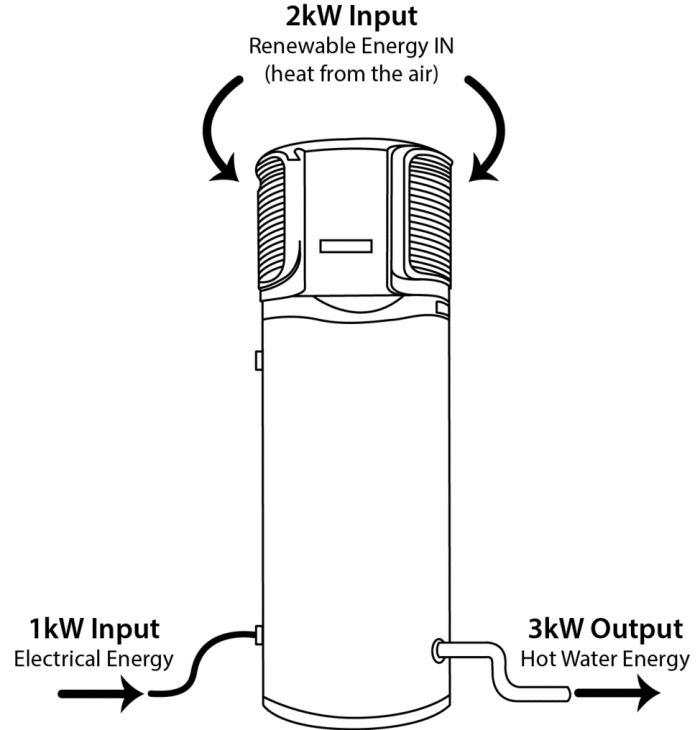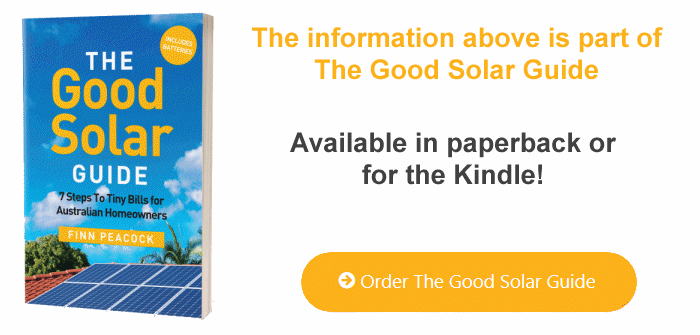STEP 3: Heating Your Water
← Collecting Meter Data | The Good Solar Guide Contents | Solar Hot Water Options →
- be clued up on the fundamental solar knowledge necessary to be informed when talking to a solar installer, and
- have guessed, or ideally measured, how much electricity you use in in the day, and how much at night
This means you’re almost ready to decide how big your solar power system should be and work out how quickly it will pay for itself, so you can decide whether to invest in solar or not.
There’s one more thing you need to do first. You need to decide how your solar-powered home will heat its water. We have to do that now because your decision can affect how many panels you’ll need.
Conventional water heating can be responsible for up to half of a typical electricity bill – so it needs your attention as part of this project. Remember, the project is all about getting your bills right down.
Your existing system
If you already have an existing solar thermal hot water system and you are happy with it, then you can jump to Step 4. If you don’t know what a solar thermal hot water system is, or currently heat your water with gas or electricity, then read on.
How your future solar home will heat its water depends on your current situation. You could:
- have an existing gas hot water system
- have an existing electric hot water system, or
- be building a home and have no existing hot water system
Scenario 1: Existing gas hot water system
If you currently have a gas hot water heater, you may think that a solar electricity system will have nothing to do with your hot water. You may even be about to skip this step entirely. But hold on a second. Let’s quantify the problem by estimating how much gas you currently use to heat water in a year.
Most four- to five-person homes will spend about $2.50 a day on gas for water heating – about $900 per year. If you have a one- or two-person home, this will be closer to a dollar fifty a day.
If you use LPG gas to heat your water, you’ll probably be paying through the nose for it. LPG is about three times the price of mains gas.
If you are happy with your water-heating cost, and happy to keep your gas connection, then jump to Step 4. If you want to knock 70% to 80% off your water-heating bills or avoid gas for environmental or geo-political reasons I recommend ripping out the gas hot water system and replacing it with solar-electric hot water. This gets you one step closer to a simpler, cheaper-to-run all-electric house. Jump past Scenarios 2 and 3 to ‘Your options for solar hot water’
Scenario 2: Existing electric hot water system
There are two types of electric hot water. The most efficient is the solar heat pump. Although heat pumps are a relatively cheap and very efficient solution in many parts of Australia, sadly they are installed in less than 2% of Aussie homes.
Heat pumps are pretty simple to understand: get an air conditioner, run it in heating mode, and use the heat it blows out to warm a well-insulated cylinder of water. A heat pump can be three and a half times more efficient than a conventional ‘kettle-style’ electric heater. For every 1 kW you put in you can get over 3 kW of heating out. Sounds like a magic pudding machine? Well, here’s how it’s done:

Figure 3.1 Energy flows in a heat pump hot water system.
If you have a heat pump and it doesn’t need replacing any time soon, skip the rest of this chapter. You already have a very efficient hot water system that will soon be powered by your new solar panels.
If your water heating is electric, chances are you don’t have a heat pump, as they are rare and more expensive than a regular ‘resistive’ hot water cylinder. A regular electric system is like a big kettle. One or two big kettle elements get really hot and heat the water.
If you’ve got one of these then you need to find out if it uses a different, cheaper tariff than the rest of your home. This tariff is often called a controlled load tariff, and I described it in Step 2.
If your hot water cylinder is on a much cheaper tariff (and perhaps your slab heating and pool pumps too) then, financially speaking, offsetting it with solar is a low priority. Your biggest savings will come from offsetting your regular tariff that powers everything else in your home.
If you have controlled load, you now have to make a decision. Do you leave your hot water and controlled load tariff alone, or do you go the whole hog and make your hot water solar along with the rest of your appliances?
To help you decide, let’s see how much you’re paying to heat your hot water with your controlled tariff. If you have a year’s worth of bills, now is the time to get them out. Add up all the ‘controlled load’ line items for the year. That is how much you pay, per year, for hot water energy.
Figure 3.2 is an example from a quarterly bill. Add these from a year’s worth of bills to see the most you could save in a year with solar hot water.
| New charges and credits | ||||
| Usage and supply charges | Units | Price | Amount | |
| Peak | 419 kWh | $0.2615 | $109.57 | |
| Tariff 33 Controlled load | 331 kWh | $0.1898 |
$62.82 |
|
| Supply charge | 96 days | $0.8581 |
$82.38 |
|
| Total charges | + $254.77 | |||
Figure 3.2 Controlled load usage on a typical bill.
If you don’t have a controlled load tariff, you can estimate how much hot water energy costs you with this rule of thumb:
Two-person households use around 8 kWh a day for heating water.
Three- to four-person households use around 10 kWh.
Households of five people or more use around 12 kWh.
Reduce this by around 1 kWh a day if you live in Brisbane or Perth and by 2 kWh if you live somewhere hotter.
Multiply this by your usage tariff, then multiply again by 365.
As an example, in South Australia a four-person house will typically use 10 kWh x 365 days = 3,650 kWh. That will cost 3,650 kWh x $0.24 = $876 per year.
Write down your estimated annual hot water electricity cost here:
_____kWh per day x 365 x $_____ per kWh = $_____ per year
Even the best grid-connected solar hot water system is unlikely to provide 100% of your hot water energy, so expect to save about 70% of that cost with solar hot water.
Now you know the numbers, the choice is yours. If you have electric water heating and want to knock 70% to 80% off your water-heating bills, read on to discover your options for solar hot water. If your hot water electricity bill is surprisingly cheap then feel free to leave your hot water alone and I’ll see you in Step 4.
Scenario 3: Building a home from scratch
The third scenario is that you’re building a home. I would strongly recommend designing your house to be 100% electric. You can have no initial and daily gas connection fees if you design solar hot water in from the outset. The rest of this chapter will show you your options.
← Collecting Meter Data | The Good Solar Guide Contents | Solar Hot Water Options →
Questions or feedback about the content on this page? Contact me.
